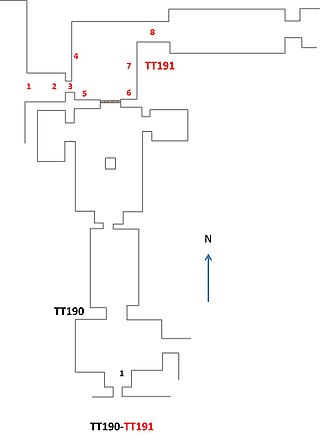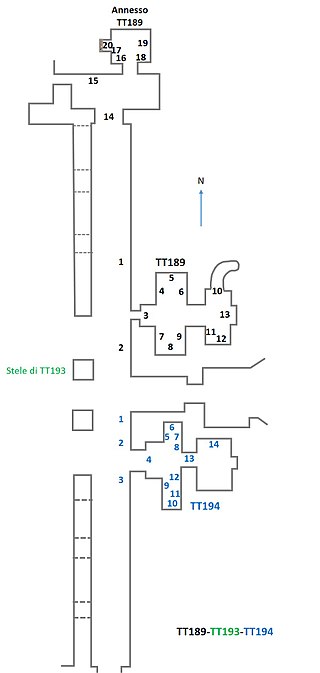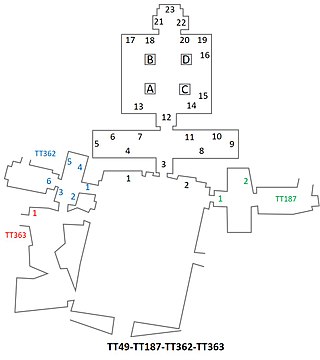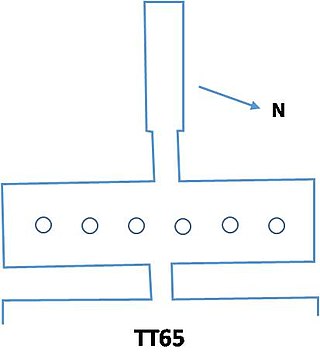Related Research Articles

Ahmose was a princess of the Seventeenth Dynasty of Egypt. She was the only known daughter of Seqenenre Tao by his sister-wife Sitdjehuti. She was the half-sister of Pharaoh Ahmose I and Queen Ahmose-Nefertari. Her titles are King's Daughter; King's Sister.
Charles Fox Burney was a biblical scholar at Oxford University, England.
The ancient Egyptian Shuroy lived during the 20th Dynasty. He was buried in a tomb in the necropolis of Dra' Abu el-Naga' on the west bank of the Nile, opposite Thebes. His titles included Head of Brazier-bearers of Amun.
Nebetnehat was an ancient Egyptian queen consort during the mid-18th Dynasty. She was the Great Royal Wife of an unidentified pharaoh. Her name is only known from an alabaster canopic fragment found in the valley of the Queens. The canopic jar was part of a find referred to as the Tomb of the Princesses.
The Theban Tomb TT34 is located in El-Assasif. It forms part of the Theban Necropolis, situated on the west bank of the Nile opposite Luxor. The tomb is the burial place of the ancient Egyptian official, Mentuemhat.

The Theban Tomb TT171 is located in Sheikh Abd el-Qurna, part of the Theban Necropolis, on the west bank of the Nile, opposite to Luxor. The name of the owner is not known. His wife was named Isis (Aset) according to an inscription on the facade. The tomb dates to the Eighteenth Dynasty of Egypt.

Tomb TT190, located in the necropolis of El-Assasif in Thebes, Egypt, is the tomb of Esbanebded and part of the TT192 tomb complex.

Tomb TT193, located in the necropolis of El-Assasif in Thebes, Egypt, is the tomb of Ptahemheb, who was a magnate of the seal in the treasury of the Estate of Amun during the Nineteenth Dynasty of Egypt. Ptahemheb's tomb is part of the TT192 tomb complex. A stele from the tomb is located in the courtyard of the tomb of Kheruef (TT192)

Tomb TT194, located in the necropolis of El-Assasif in Thebes, Egypt, is the tomb of Thutemhab (Djehutyemhab), who was an overseer of the marshland-dwellers of the Estate of Amun and a scribe in the temple of Amun during the Nineteenth Dynasty of Egypt. Thutemhab's tomb is part of the TT192 tomb complex.

Tomb TT195, located in the necropolis of El-Assasif in Thebes, Egypt, is the tomb of Bekenamun, who was a scribe in the treasury of the Estate of Amun during the Nineteenth Dynasty of Egypt. Bekenamun's tomb is part of the TT192 tomb complex.

Nakhtubasterau (Nakhtbastetiru) was the Great Royal Wife of Amasis II. She dates to the Twenty-sixth Dynasty of Egypt. Her name honors Bastet.
The Theban Tomb TT61 is located in Sheikh Abd el-Qurna. It forms part of the Theban Necropolis, situated on the west bank of the Nile opposite to Luxor.

Tomb TT187, located in the necropolis of El-Khokha in Thebes, Egypt, is the tomb of a wab-priest of Amun named Pakhihet.

Tomb TT174 is in El-Khokha, located in the Theban Necropolis in Thebes, Upper Egypt. It is the sepulchre of Ashakhet, who was a priest in front of Mut. The tomb dates to the 19th Dynasty.
Rosalind Louisa Beaufort Moss, FSA was a British Egyptologist and bibliographer, noted for her work on The Topographical Bibliography of Ancient Egyptian Hieroglyphic Texts, Reliefs and Paintings.

The Theban Tomb TT63 is located in Sheikh Abd el-Qurna. It forms part of the Theban Necropolis, situated on the west bank of the Nile opposite to Luxor.

The Theban Tomb TT65 is located in Sheikh Abd el-Qurna. It forms part of the Theban Necropolis, situated on the west bank of the Nile opposite to Luxor.

Tomb TT374, located in the necropolis of El-Khokha in Thebes, Egypt, is the tomb of the Scribe of the Treasury of the Ramesseum, Amenemope.
Amenmose, Son of Pendjerty was a royal scribe from the time of Ramesses II. Amenmose was the son of the judge Pendjerty and the sistrum bearer of Amun, Mut and Khonsu, named Mutemonet.

Tomb TT407, located in the necropolis of El-Assasif in Thebes, Egypt, is the tomb of Bintenduanetjer, who was the Chamberlain of the Divine Adoratrice, and dates to the Saite period.
References
- 1 2 3 4 Lesko, Barbara S. "Bertha Porter (1852-1941) and Rosalind Moss (1890-1990)" (PDF). Breaking Ground: Pioneering Women Archaeologists. Brown University.
- ↑ "Dictionary of Irish Architects 1920-1940 - Porter, Frederick William". Irish Architectural Archive. Retrieved 27 September 2016.
- ↑ "Bertha Porter (1852 – 1941)". kent-maps.online. Archived from the original on 23 October 2021. Retrieved 23 October 2021.
- ↑ "Topographical Bibliography (Porter & Moss)". The Griffith Institute. Retrieved 11 October 2024.